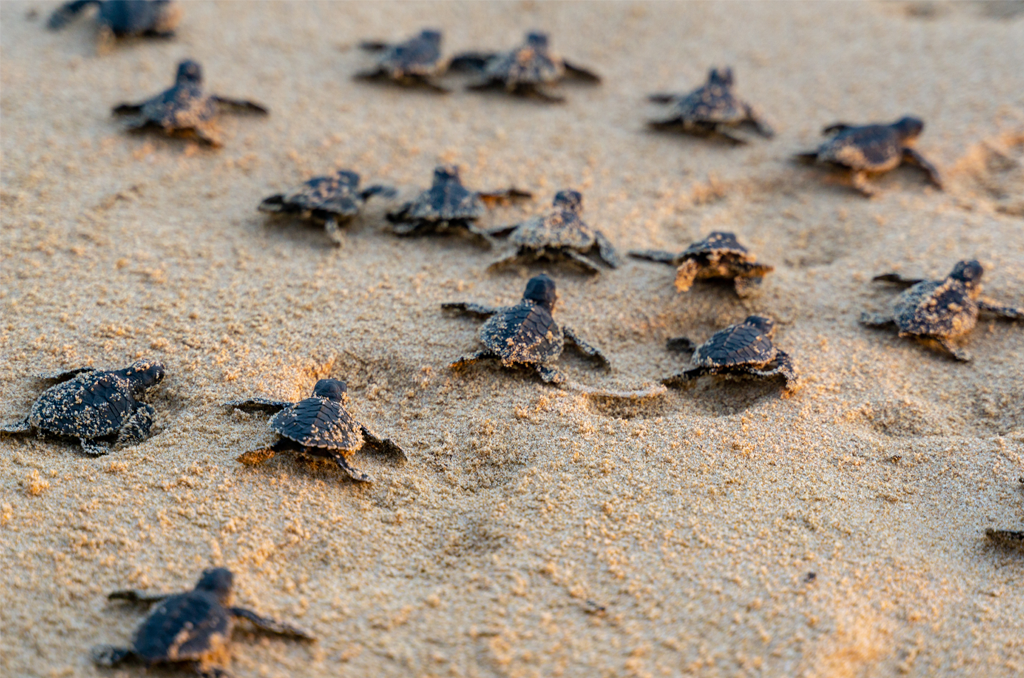Sea turtle hatchlings on beach – Courtesy: Shutterstock – Image by Julian Wiskemann
Thousands of sea turtles have spent the last few months making the arduous journey from the ocean to beaches in the United States to deposit their eggs, just as they have done for millions of years. Despite mounting concerns about the challenges posed by climate change, record nesting was observed this year in Florida and other places.
Preliminary state data for Florida indicates that there are over 133,840 loggerhead turtle nests, shattering the previous record set in 2016. The estimate of at least 76,500 green turtle nests is significantly higher than the previous high achieved in 2017.
Although not all of them broke records like Florida, where Justin Perrault, vice president of research at the Loggerhead Marinelife Center in Juno Beach, stated the number of nests is outstanding this year, high sea turtle nest numbers have also been observed in South Carolina, Alabama, North Carolina, and Georgia.
“We broke the local record by 4,000 nests, and we had more nests than we had ever seen on our local beaches,” stated Perrault, whose group watches over Palm Beach County. “That’s quite a bit of nesting.”
The loggerhead, green, leatherback, hawksbill, Kemp’s ridley, olive ridley, and flatback are the seven species of sea turtles. They’re all categorized as threatened or endangered. On summer evenings, they come ashore, dig burrows in the sand, lay dozens of eggs in them, cover them up, and go back out to sea. One of the most significant loggerhead turtle hatcheries in the world is located on Florida beaches.
Just one marine turtle hatchling out of every 1,000 survives to adulthood. Numerous natural risks confront them, such as predators both on land and in the ocean, disturbances to their nests, and the inability to reach the sea following hatching. This year, the majority of the nests over a 75-mile length of Florida’s Gulf Coast that had been tallied were destroyed by Hurricane Idalia’s surge in August.
“Sadly, the high tides and flooding on our barrier islands caused nearly all of the nests prior to Idalia to be lost,” stated Carly Oakley, senior turtle conservation biologist at Clearwater Marine Aquarium.
According to her, female turtles typically produce eggs every three years, resulting in years when nests are up and down. “The nesting process is very exhausting and, in this break, females regain the energy to do the process again,” Oakley stated.
These difficulties have been made worse by climate change, which is creating stronger tropical storms and a reduction in beaches due to rising sea levels. The chances of survival are further decreased by hotter air, water, and sand as well as modifications to the ocean currents that turtles utilize to migrate, according to the worldwide conservation organization Oceana.
Sea turtle sex is mostly determined by the temperature of the sand. Warmer weather generally results in more female turtles, and researchers at Florida State University predict that global sand temperatures will rise sharply by 2100.
“So the warmer the nest is, the more likely that nest is to produce females,” Perrault explained. “Additionally, hatchlings that come out of warmer nests are much smaller and often slower.”
According to a study conducted by Mariana Fuentes, an FSU professor, and just published in the journal Global Change Biology, sea turtles will need to nest either considerably later or much earlier than they do now in order to adapt to changing climatic conditions.
According to Fuentes, who works in the Department of Earth, Ocean, and Atmospheric Science at FSU, even that might not be sufficient for every species. Although turtles have evolved over millions of years to survive in many climates, she noted that the fast changes of today may occur too quickly for them to do so.
“We have found that even if they do change the timing of their nesting, that’s not going to be sufficient to maintain the temperatures of current nesting grounds,” Fuentes stated.
In regions where seawalls have been erected by humans, sea turtle mothers already have to haul themselves out of the water in order to find a suitable location for their nests. Before locating a suitable spot, some female turtles attempt multiple times, a maneuver called a false crawl.
Before being gobbled up by birds and other animals, hatchlings must crawl to the sea after being raided by raccoons, coyotes, and other predators. Turtles may become disoriented by electric lights and move in the incorrect direction on the beach instead of following the light from the stars and moon. And voracious fish await those who are ultimately fortunate enough to begin swimming.
Tens of thousands of hatchlings fail to reach the water, according to Michelle Pate, a scientist with the South Carolina Department of Natural Resources, despite an increase in nest numbers over most of the Southeast.
“If we can’t get hatchlings to emerge and make it to the ocean, then an increase in nest numbers doesn’t help,” she stated.
According to Perrault, the rise in turtle nests this year hides a dire future for the creatures.
“Yes, we’re seeing record numbers, but our hatchling production may not be that great,” he said. “And so in the future, 20 to 30 years from now, and these things come back to nest, we may not be seeing these record numbers that we’re seeing now.”
Stories that matter are our priority. At Florida Insider, we make sure that the information we provide our readers is accurate, easy-to-read, and informative. Whether you are interested in business, education, government, history, sports, real estate, nature or travel: we have something for everyone. Follow along for the best stories in the Sunshine State.

Born and raised in South Florida, Krystal is a recent graduate from the University of Miami with professional writing experience at the collegiate and national news outlet levels. She’s a foodie who loves all things travel, the beach, & visiting new places throughout Florida.

